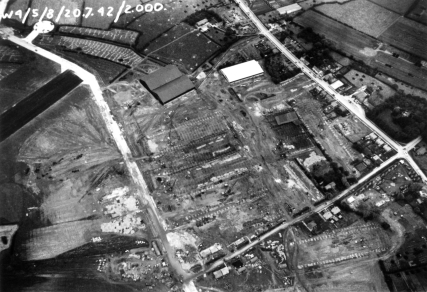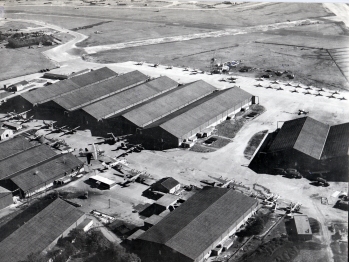The origins of Warton Aerodrome begin in 1938. Nearby Blackpool Squires Gate Airfield, an RAF Coastal Command station that handled detachments of fighter and bomber aircraft, identified a requirement for a satellite airfield. The Air Ministry announced an interest in Grange Farm, the Preston Corporation’s sewage farm located outside of Freckleton, on the 21st October 1938. Just under a month later the Air Minister, Sir Kingsley Wood, stated in a letter that Grange Farm was unsuitable for the Ministry’s purpose. A new site was identified and deemed suitable across Freckleton Pool in Warton. Construction of three concrete runways began at the site in 1940.

Before construction of the runways at Warton had begun, the minister of aircraft production had recognised the requirement for aircraft maintenance and repair facilities in the United Kingdom. The minister, Lord Beaverbrook, had raised such a requirement to facilitate the ever increasing number of aircraft being supplied by the US under the lend lease program.
Following a visit by a team of USAAF observers on the 19th May 1941, Lord Beaverbrook was requested in October 1941 to recommend a number of sites for use as an Air Depot by the USAAF. The United States entered the war in December 1941. Four sites were recommended for use by General Brett: Warton, Burtonwood, Langford Lodge, and Little Staughton. In January 1942 his recommendations were actioned, and Frank Thomas was instructed to lead the design and construction of these sites by the DGAP(F). A detailed agreement was reached by USAAF and British authorities for development of the sites in March 1942. Construction began at Warton, with the view that the base would be up and running by October.
Warton was to become Station 582 of the 8th Air Force. The three runways constructed in 1940 were strengthened, and, the main runway was extended in order to accommodate large aircraft. Construction was stepped up in June 1942, in order to meet the October deadline. Hangars, workshops, engine test cells, MT shops, armouries, and stores were amongst the many buildings designed and built around the airfield. Ten accommodation sites were constructed in order to house 15,902 persons. A chapel, hospital and cinema were to be provided along with other facilities for personnel. The construction of Warton’s airbase was carried out by Alfred McAlpine, later joined by Wimpey. Warton Air Depot, USAAF Station 582, was finally established on the 5th September 1942. It became known as BAD-2, short for Base Air Depot 2, on the 21st October 1943.

The first contingent of USAAF personnel arrived on the 18th August 1942. To meet the need for trained personnel, the 8th Air Force Service Command had suggested that Lockheed Overseas Corporation run the facility with civilians, but USAAF HQ rejected this. On 17th July 1943 Warton was formally handed over to the USAAF, with 5,000 US personnel working there. Aircraft started arriving not long after the USAAF personnel did. Bombers were flown across the Atlantic, and fighters came by sea, mainly to Liverpool, from where they were towed along the road to Speke and flown to Warton or Burtonwood. Alternatively they sailed to Glasgow and were towed to Renfrew for the onward flight. Aircraft processing began at the site in April 1943. Warton specialised in B-24 Liberators, P-51 Mustangs, and in-line engines whilst B-17 Flying Fortresses, P-38 Lightnings, and radial engine types went to Burtonwood. Warton processed 10,068 aircraft including every type of US aircraft used in Europe in WWII and several British types as well. This number excludes almost 4,000 that were cleared by inspection only and ferried on to their respective Squadrons and Groups. As well as the aircraft section, Warton was home to several maintenance sections. Manufacture and repair, engine, radio and signal, instrument, parachute and textile, and accessories sections were responsible for the issue of over 2,443,915 items ranging from life rafts to V-1650 Packard Merlin Engines.

By the end of June 1945, only aircraft maintenance work was underway at Warton. Manufacturing, engine overhaul and other work had ended. Warton closed as an active USAAF base with the end of hostilities with Japan a couple of months later. The last aircraft was delivered on the 2nd of August 1945 and BAD 2 was de-activated on the 3rd of September, at midnight, under the command of Colonel T.W. Scott. From January 1945, many men had begun to be transferred to Infantry units. The few remaining staff moved to site 8 and in September the airfield became the ‘Warton Army Technical School.’ The school was set up to provide comprehensive technical and industrial training for American servicemen prior to return to civilian life. The first 2,151 students started their course on the 16th of September 1945 and up to 4,000 students started on one of 18 courses each 8-week term. At the end of that year the number of US Servicemen based at Warton was down to 5,000. The airfield was handed back to the RAF in February 1946, after the Technical School moved to Germany.

Thankyou so much x
LikeLiked by 1 person
Thank you for this. It was fascinating. My uncle worked on the base as a fireman
LikeLiked by 1 person
My dad was fire chief… Lt. Jack Thias
LikeLike
Good stuff! You have filled in a couple of gaps in my own online local history at http://www.blackpoolhistory.co.uk
Cheers
LikeLike
Thank you very much for your work on keeping the memories of Warton BAD2 alive. My father was assigned as a Staff Sargeant there in the office crew and often said this was the best training for running the business he came back to in the states when he returned after the war. Dad married a local gal, so he went back several times. I was fortunate to have toured the remains of BAD2 as a kid with Dad. Any photos of the office crews?
LikeLike
Info on BAD2. Plans layout – I grew up in Freck and am interested to see what Freck and Warton were like when the base was newly built
LikeLike
I believe an extension of the base in Warton and some of the American left over parts are buried under the land at School farm. Can you confirm this please? And do you have any other information on school farm opposite Warton Bae?
LikeLike